Neurofibromatosis
Neurofibromatosis is a genetic condition that is characterized by the formation of benign (noncancerous) tumours along nerve tissue.
Anatomy
The noncancerous tumours can develop anywhere along your nervous system including the brain, spinal cord, and nerves.
Causes
Neurofibromatosis is caused due to genetic mutations that may occur spontaneously or are inherited from a parent.
Types of disease
Neurofibromatosis 1: This is the most common form of neurofibromatosis. Signs and symptoms are apparent during infancy or childhood.
Neurofibromatosis 2: A less common form of the disease. Signs and symptoms are apparent during late teenage years.
Schwannomatosis: This is a rare type of neurofibromatosis. Signs and symptoms become apparent after the age of 20.
Symptoms
Neurofibromatosis 1: Symptoms include light brown spots on the skin, freckles in the armpits and groin, tiny nodules on the iris, soft bumps under or on the skin, bony deformities such as a bowing of the leg or curving of the spine, increased head size, and short stature.
Neurofibromatosis 2: Symptoms include progressive loss of hearing, ringing in the ears, unsteadiness, headaches, facial droop, vision difficulties, numbness and weakness of the extremities, pain.
Schwannomatosis: Symptoms include loss of muscle mass, numbness and weakness in different parts of the body.
Untreated
Complications of untreated neurofibromatosis include:
- Neurological problems with learning and thinking difficulty
- Skeletal deformities that can result in scoliosis and osteoporosis
- Visual problems
- Poor self-image
- Cardiovascular and pulmonary issues
- Deafness
- Weakness
- Development of brain tumours
Diagnosis
Your doctor will discuss your symptoms, medical history, and family medical history. A complete physical evaluation will be performed including a thorough eye and ear exam to identify signs of the disease. Imaging studies such as X-rays, CT scans, and MRIs may be performed to detect bone abnormalities and the presence of tumours within the body. Genetic testing may also be performed to confirm the diagnosis.
Treatment Options
Treatment of neurofibromatosis consists of alleviating the signs and symptoms of the disease as and when they occur. This includes monitoring lesions and blood pressure, evaluating growth and development, regular eye examinations, and assessing cognitive skills. Medications to control nerve pain, antiepileptic medication, and antidepressants may also be prescribed. Surgical removal of tumours is recommended if there is compression of surrounding structures causing complications such as hearing loss or severe pain. Hearing loss can be improved with the use of auditory implants. The sooner your child is diagnosed and under the care of a doctor, the more favourable will be the outcome of treatment.




